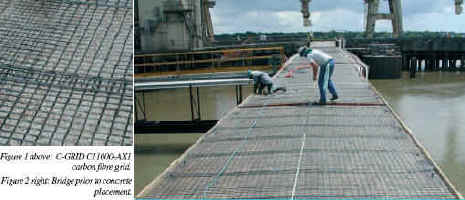Industries Served
Carbon Fiber Tech
Carbon fiber technologies team up to strengthen bridge
 The CHS Myrtle Grove export terminal is located on the Mississippi River, about 30 miles south of New Orleans, and is the southernmost grain terminal in Louisiana. The facility receives grain by barge and rail, and loads out grain by vessel. A four-span access bridge connects the dock to the main facility, which is located behind a levee. The access bridge provides the only access to the dock and is critical to the operation of the terminal.
The CHS Myrtle Grove export terminal is located on the Mississippi River, about 30 miles south of New Orleans, and is the southernmost grain terminal in Louisiana. The facility receives grain by barge and rail, and loads out grain by vessel. A four-span access bridge connects the dock to the main facility, which is located behind a levee. The access bridge provides the only access to the dock and is critical to the operation of the terminal.
Gregg Blaszak, TechFab LLC, Anderson, South Carolina, USA

The 3.6m-wide bridge consists of two T-beams topped with a reinforced concrete overlay and carries light-duty construction vehicles to and from the terminals to carry out unloading operations and dock maintenance. A recent inspection and subsequent design review to strengthen the beams and cantilevered flanges was conducted to incorporate the usage of a 22-tonne hydraulic crane for maintaining dock equipment. Due to the importance of the bridge to the overall operation of the CHS terminal, all repairs had to be completed within a five day window during a planned maintenance shutdown.
Complementary strengthening systems:
Carbon fiber fabric:
Two complementary carbon fibre technologies were implemented to strengthen the bridge for the current loadings. In order to increase the flexural and shear strengths of the T-beams, the En-Force FTS carbon fibre strengthening system was externally bonded to the bottoms and sides of the beams. This system comprised thin unidirectional carbon fibre fabrics that were easily installed on site using wet lay-up techniques.
Carbon fiber grid:
An additional concrete topping, reinforced with C-GRID C11000-AX1 carbon fibre grid, manufactured by TechFab, LLC, was used to strengthen the cantilevered flanges of the T-beams. The grid system enabled the use of a 50mm topping, about half what would have been required had traditional steel reinforcement been used. The thinner topping translated into less dead load that had to be supported by the already deficient beams making the externally bonded carbon fibre beam upgrades possible. While an externally bonded carbon fibre solution was considered for strengthening the flanges, it was quickly dismissed because vehicles travelling over the bridge could have damaged the carbon fibre sheets.
 The fibre grid works like welded wire reinforcement but requires much less cover since it does not corrode like steel reinforcement. It comprises tightly spaced, high-strength carbon strands providing nominal tensile strengths of 11.7kN/m and 110kN/m in the longitudinal and transverse directions, respectively.
The fibre grid works like welded wire reinforcement but requires much less cover since it does not corrode like steel reinforcement. It comprises tightly spaced, high-strength carbon strands providing nominal tensile strengths of 11.7kN/m and 110kN/m in the longitudinal and transverse directions, respectively.
Installation technique:
The carbon fiber grid was delivered to the site in 90m rolls that were subsequently cut into 3.6m lengths using hand-held metal shears or grinders to match the width of the bridge. The crew placed the grid sections on the existing slab and lifted them into place using rakes while pouring the concrete. A high slump, pea gravel, concrete mix was used to facilitate placement and ensure good consolidation around the carbon grid. The material was generally found to be easy to handle and work with.


Conclusion
Python Corporation, a Louisiana-based concrete repair contractor, easily completed the repairs within the narrow construction window and the access bridge reopened in time for the terminal to begin receiving grain shipments. TechFab LLC wish to mention that C-GRID is a a new material without the extensive performance history of conventional construction materials. The use of C-GRID in critical health and safety applications is not Consultant: recommended until additional use experience and test data have been obtained. The use of CGRID for use in fire-rated applications is not recommended. C-GRID, like all TechFab FRP reinforcements, exhibits linear elastic behavior. Accordingly, the appropriate design, safety, load and strength-reduction factors must be considered and applied for specific concrete reinforcement applications. In cases where serviceability or structural performance may be affected, the
application should be reviewed and approved by a registered professional engineer. Typical physical properties as reported by the manufacturer are subject to change from time to time.
Contractor:
Python Corporation
Consultant:
Lanier & Associates Consulting Engineers, Inc.
Materials Supplier:
TechFab LLC and Structural Composites, Inc




